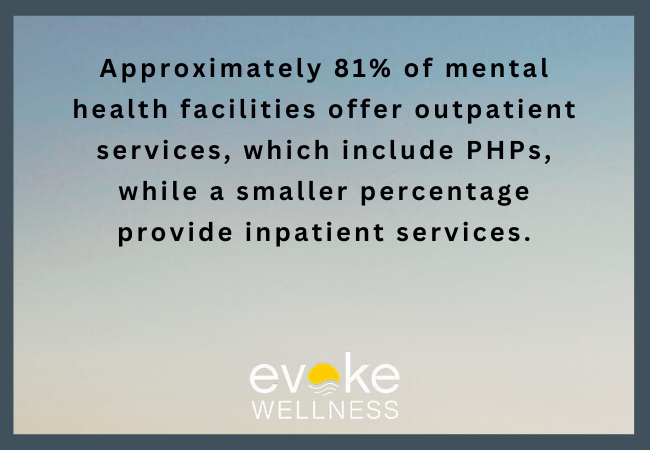Choosing the right level of care for addiction and mental health treatment is a crucial step in the recovery journey. Both inpatient rehab and Partial Hospitalization Programs (PHP) offer structured support, but they cater to different needs. Understanding the differences can help individuals and their loved ones make informed decisions about their treatment options.
Rehabilitation is not a one-size-fits-all approach, and the best treatment plan depends on the severity of the addiction, co-occurring mental health disorders, medical needs, and personal responsibilities. This article explores the key differences between inpatient rehab and PHP, their benefits, and how to determine which program is the best fit for long-term recovery.
What is Inpatient Rehab?
Inpatient rehab, also known as residential treatment, is an intensive level of care that requires individuals to live at the treatment facility for a designated period, usually ranging from 30 to 90 days or longer. This immersive environment is designed to provide round-the-clock medical supervision and therapeutic support.
Key Features of Inpatient Rehab
- 24/7 Medical and Psychological Support – Individuals receive continuous care from medical professionals, therapists, and support staff.
- Structured Daily Schedule – Treatment includes individual and group therapy, behavioral therapy, medication management, and holistic activities.
- Safe and Controlled Environment – The residential setting eliminates access to drugs and alcohol, reducing the risk of relapse.
- Dual Diagnosis Treatment – Many inpatient facilities specialize in treating both substance use and mental health disorders.
- Medical Detoxification – For individuals with severe withdrawal symptoms, inpatient programs offer medical detox to ensure safety and comfort during the early stages of recovery.
Inpatient rehab is often recommended for those with severe addiction, a history of relapse, or co-occurring mental health disorders that require intensive supervision.
What is Partial Hospitalization Programs (PHP)?
A Partial Hospitalization Program (PHP) provides a high level of care while allowing individuals to return home in the evenings. PHP serves as a bridge between inpatient rehab and outpatient treatment, offering structured therapy and medical support without full-time residential care.
Key Features of PHP
- Comprehensive Treatment During the Day – Individuals participate in intensive therapy for several hours each day, multiple days per week.
- Flexibility for Personal Responsibilities – Unlike inpatient rehab, PHP allows individuals to maintain family, work, or school commitments.
- Medical and Therapeutic Support – While less intensive than inpatient care, PHP still provides medical oversight and behavioral therapy.
- Gradual Transition to Independence – PHP helps individuals develop coping strategies and transition to everyday life while still receiving structured care.
PHP is ideal for those who need intensive treatment but have a stable home environment and do not require 24/7 supervision.
Comparing PHP and Inpatient Rehab
Treatment Intensity
Inpatient rehab provides 24/7 care, making it ideal for individuals with severe addiction, while PHP offers intensive treatment during the day but allows individuals to return home in the evenings.
Medical Supervision
Both programs provide medical oversight, but inpatient rehab offers continuous monitoring, which is crucial for those undergoing detox.
Flexibility and Independence
PHP provides more flexibility, making it a better choice for those with work or family obligations, while inpatient rehab requires full-time commitment.
Cost Considerations
Inpatient rehab is generally more expensive due to the costs of housing, meals, and 24/7 care. PHP is a more affordable option while still providing structured treatment.
Benefits of Inpatient Rehab
Inpatient rehab is often the best choice for individuals with severe addiction or a history of relapse. Some of the main benefits include:
- Immersive Healing Environment – A residential setting allows individuals to focus entirely on recovery.
- Immediate Access to Medical Care – Those with withdrawal symptoms or medical complications receive prompt medical attention.
- Structured Routine – Daily therapy sessions, healthy meals, and wellness activities promote overall well-being.
- Higher Success Rates – Studies show that long-term residential treatment improves the likelihood of sustained recovery.
However, inpatient rehab requires a significant time commitment and may not be suitable for those with work, school, or family obligations.
Benefits of PHP
PHP provides many of the benefits of inpatient rehab while allowing individuals to return home each evening. Some advantages include:
- Flexibility – Individuals can receive treatment while maintaining personal responsibilities.
- Strong Support Network – Those with a supportive home environment benefit from both professional treatment and personal connections.
- Cost-Effective Option – PHP is generally more affordable than inpatient rehab while still providing intensive care.
- Gradual Transition to Independence – PHP helps individuals integrate recovery skills into daily life, reducing the risk of relapse.
PHP is best suited for individuals who require structured treatment but do not need 24/7 supervision.
PHP vs. Inpatient Rehab: A Side-by-Side Comparison
| Feature | Inpatient Rehab | Partial Hospitalization Program (PHP) |
|---|---|---|
| Residential Requirement | Yes (live at the facility) | No (return home each night) |
| Care Intensity | 24/7 medical and therapeutic care | Daily care (4–6 hours/day, 5 days/week) |
| Best For | High-risk, unstable, or in active crisis | Stable, post-detox, or transitioning from inpatient |
| Freedom & Flexibility | Minimal (no work, home, or phone use) | Moderate (can maintain home responsibilities) |
| Cost | Generally higher due to housing & supervision | Lower—no room/board costs |
| Length of Stay | 28–90 days (varies by individual/program) | 2–6 weeks on average |
How to Decide: Questions to Ask
To determine the best level of care for yourself or a loved one, consider these questions:
-
Do I need 24/7 support to stay safe and sober?
-
If yes → Inpatient rehab is likely the right choice.
-
-
Can I manage triggers and responsibilities outside of treatment hours?
-
If yes → PHP may be an effective, flexible solution.
-
-
Have I recently completed detox or inpatient treatment?
-
If yes → PHP is a strong next step in the continuum of care.
-
-
Do I need medical detox or crisis stabilization?
-
If yes → Start with inpatient care and consider PHP after.
-
-
Am I motivated to stay sober but still struggling with symptoms or structure?
-
If yes → PHP can provide the daily support you need.
-
Choosing the Right Program
When deciding between inpatient rehab and PHP, individuals should consider factors such as the severity of their addiction, medical needs, personal responsibilities, and financial situation. Consulting with an Addiction Treatment Center in Massachusetts can help determine the most suitable treatment plan based on individual circumstances.
Finding Support for Addiction Treatment
Whether you choose inpatient rehab or a Partial Hospitalization Program Waltham, MA, seeking professional care increases the chances of long-term recovery. Treatment programs provide essential resources, including therapy, medication management, and relapse prevention strategies, to help individuals rebuild their lives.
For those struggling with co-occurring disorders, integrating Mental Health Therapy Programs in Massachusetts into addiction treatment can address underlying mental health concerns and improve recovery outcomes.
Why Choose Evoke Waltham’s PHP?
At Evoke Waltham, we specialize in helping individuals stabilize, recover, and rebuild after addiction and mental health struggles. Our Partial Hospitalization Program in Waltham, Massachusetts offers:
-
A compassionate team of licensed professionals
-
Dual diagnosis and trauma-informed care
-
Evidence-based therapy (CBT, DBT, MI)
-
Flexible support that allows for real-world reintegration
-
Access to holistic services like yoga, mindfulness, and nutrition education
-
Seamless step-down to IOP and outpatient levels of care
Whether you’re stepping down from inpatient treatment or need more than weekly therapy, our PHP helps you stay focused, connected, and on track.
Conclusion
Both inpatient rehab and PHP offer valuable paths to recovery, each catering to different needs and lifestyles. Understanding the differences between these levels of care can empower individuals to make informed decisions about their treatment journey. Seeking professional guidance and support is the first step toward lasting recovery.
Call Evoke Waltham today at 866.395.3110 to speak with our admissions team and learn whether our Partial Hospitalization Program in Waltham, Massachusetts is the best next step for your recovery.
Frequently Asked Questions
What is the main difference between inpatient rehab and PHP?
Inpatient rehab requires individuals to live at the facility full-time, providing 24/7 medical and therapeutic support. PHP offers intensive treatment during the day, allowing individuals to return home each evening.
Who should consider inpatient rehab?
Inpatient rehab is recommended for individuals with severe addiction, withdrawal symptoms, or co-occurring mental health disorders that require round-the-clock supervision.
Is PHP as effective as inpatient rehab?
PHP is highly effective for individuals with a stable home environment who do not need 24/7 medical care. However, those with severe addiction may benefit more from inpatient treatment.
How long does PHP last?
PHP duration varies but typically lasts several weeks to months, depending on individual progress and treatment needs.
Can I transition from inpatient rehab to PHP?
Yes, many individuals step down from inpatient rehab to PHP as part of a continuum of care, allowing for a smoother transition into independent living while maintaining structured support.



